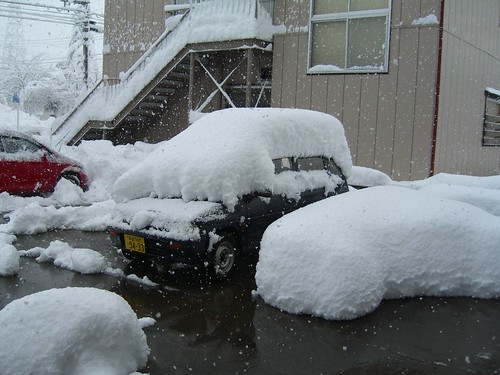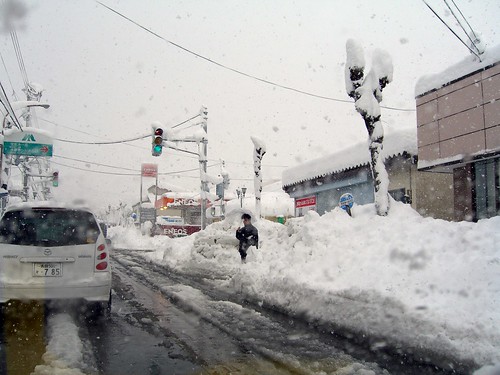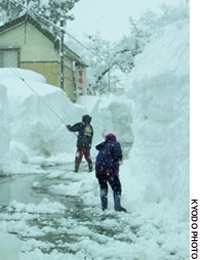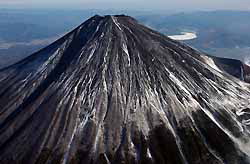雪があるよ!We got snow!!
Here are two articles from the Japan Times and a photo regarding the incredible amount of snow we are having..last year everyone was amazed because it was the most snow in 15 years, well this year has outdone that with the most snow in over 60 years (well that is what they are saying) (sorry the whole death toll thing is a bit morbid, but the article about the snow was interesting..)

GSDF troops are called in to help dig outHeavy snow expected to continue in wide areas as death toll rises to 63
NAGANO (Kyodo) A Ground Self-Defense Force unit in Nagano Prefecture was dispatched Saturday to help deal with heavy snowfall as the Meteorological Agency warned that snow will continue blanketing northern and western Japan.
By 5 p.m., more people were confirmed to have died due to snow-related incidents, bringing the death toll to 63 across 16 prefectures since the snow season began in early December, according to a Kyodo News tally based on reports from authorities. The number of people injured came to 1,040 in 28 prefectures.
Public transportation was affected, with the Joetsu Shinkansen Line suspending operations temporarily and the Tokaido Shinkansen Line experiencing delays, affecting some 130,000 people.
The GSDF Matsumoto garrison sent its disaster relief unit to Iiyama to remove snow in the first such mobilization of a GSDF unit this winter. It is the first time Nagano has received such GSDF assistance since January 1981.
The Nagano Prefectural Government issued the request Friday night.
About 100 GSDF personnel began removing snow on roads so ambulances and other emergency vehicles could pass, and around houses that could be isolated due to snow, garrison officials said.
Niigata Prefecture also asked the GSDF on Saturday to send a disaster relief unit to the town of Tsunan.
In Iiyama, more than 200 cm of snow had accumulated as of 8 a.m. Saturday. The Nagano Local Meteorological Observatory forecast up to 70 cm of snow for the area between Saturday and Sunday.
According to the Meteorological Agency, cold air of minus 30 to 40 degrees is expected to pass over western, eastern and northern Japan as a strong winter pressure pattern emerged near the country.
Some areas saw accumulation of more than 300 cm. As of 5 p.m., Tsunan recorded 357 cm, the city of Myoko in Niigata Prefecture 324 cm and the village of Nozawaonsen in Nagano 309 cm. A total of 34 observatory points had marked new snowfall records for the month of January by Saturday.
Up to 70 cm of snowfall was expected by 6 p.m. Sunday in Niigata and Nagano prefectures, 50 to 60 cm in Hokkaido and along Sea of Japan coastal areas in the Tohoku region, and 30 to 40 cm in Gunma Prefecture, the Hokuriku region excluding Niigata, the northern Kinki region and Gifu Prefecture.
The Japan Times: Jan. 8, 2006
Blizzard deaths hit 81; weekend thaw in works
NIIGATA (Kyodo) The nationwide death toll from the recent blizzards rose to 81 Thursday with the finding of five more bodies, and helicopter relief and airlift operations were hampered by poor visibility and strong winds.
Residents shovel snow to keep the road in front of their houses clear.
The Meteorological Agency meanwhile issued an avalanche warning to snow-packed areas because it expects temperatures to rise nationwide from Friday to Sunday.
The number of deaths from snow-related incidents since December rose to 81 in 17 prefectures Thursday after a 75-year-old man in Yamagata Prefecture died after being buried in snow and four other men were found dead in Fukui and Gifu prefectures.
The body of Yasutaro Oba, 75, was found by his house in Mamurogawa, Yamagata Prefecture, on Wednesday buried in snow that had fallen from his roof, police said.
The other four men died in similar accidents sometime between Dec. 18 and Jan. 11, according to the Fukui Prefectural Government.
In Nagano Prefecture, a chopper planning to carry a medical team to an isolated part of the village of Sakae was scrubbed due to bad weather.
The Ground Self-Defense Force meanwhile entered its third day of snow-relief efforts, working to clear a key road linking a Niigata Prefecture town with a Nagano Prefecture village that have been isolated since Sunday's record snowfall.
In Tsunan, Niigata Prefecture, nine elementary and junior high schools held ceremonies to mark the beginning of the school term, two days later than scheduled.
One branch school, however, postponed the ceremony because a police helicopter that was to carry teachers to the isolated school was unable to fly due to strong winds.
The Japan Times: Jan. 13, 2006(C) All rights reserved
yet there are people freaking out over the LACK of snow on Mt Fuji, oh japan...
Experts say no reason to worry about lack of snow on top of Mount Fuji
The top of Mount Fuji is covered by little snow on Thursday. (Mainichi)The surface of the ground at the top of Mount Fuji is still exposed due to a lack of snow this season despite record snowfalls in other parts of the country that have killed dozens of people and disrupted transportation systems on the Sea of Japan coast.This winter's first snowfall on Japan's highest mountain was observed on Oct. 11 last year, 10 days earlier than the previous year. Japan saw an extremely cold New Year's Day with a massive amount of snow falling in many parts of the archipelago.Nevertheless, there has since been little snow on Mount Fuji because of a lack of precipitation in areas along the Pacific coast of the Tokai and Kanto regions in central and eastern Honshu, the Meteorological Agency said.The amount of rain in December was zero in Shizuoka, as compared with 59.6 millimeters on average, and 3.5 millimeters in Tokyo as compared with the normal of 39.6 millimeters, according to the agency. Mount Fuji stands on the border of Shizuoka and Yamanashi prefectures.There has been little rain because of a winter atmospheric pattern of western high and eastern low. The atmospheric pattern causes cold winds to blow from the continent into areas along the Sea of Japan coast. Since such winds have gathered moisture after absorbing steam from the sea, they form rain clouds. The rain clouds develop into thunderclouds after hitting mountains in inland areas of Honshu, bringing heavy snow to areas along the Sea of Japan coast.The winds that become cold and dry after causing snowfalls then blow into districts along the Pacific coast.Even though it has snowed on Mount Fuji this season, the snow was blown away by strong winds caused by the winter atmospheric pattern.The Shizuoka Local Meteorological Observatory forecasts that the winter atmospheric pattern will ease from Friday to Sunday and allow a low-pressure system to pass along the south coast of the Japanese archipelago, possibly bringing snow to the Tokai and Kanto areas."If the forecast proves correct, the top of Mount Fuji may be covered in snow," an observatory official said.Experts have dismissed presumptions that the lack of snow is a sign of a volcanic eruption."No irregular seismic data regarding Mount Fuji have been observed and its volcanic activity is quite stable. There is no correlation between snow and volcanic activity. It's simply a meteorological phenomenon," said Toshitsugu Fujii, professor at the University of Tokyo's Earthquake Research Institute. (Mainichi)January 12, 2006
Copyright 2004-2005 THE MAINICHI NEWSPAPERS. All rights reserved




0 Comments:
コメントを投稿
<< Home